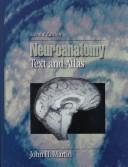| Listing 1 - 3 of 3 |
Sort by
|
Book
ISBN: 9780071603966 Year: 2012 Publisher: New-York : McGraw-Hill,
Abstract | Keywords | Export | Availability | Bookmark
 Loading...
Loading...Choose an application
- Reference Manager
- EndNote
- RefWorks (Direct export to RefWorks)
The most comprehensive approach to neuroanatomy from both a functional and regional perspective NEW full-color images! Neuroanatomy Text and Atlas explores how parts of the nervous system work together to regulate body systems and produce behavior. The book thoroughly covers the sensory, motor and integrative systems of the brain and presents an overview of the function in relation to structure and the locations of major pathways and neuronal integrative regions. Features NEW full-color images NEW a case study or a clinical description question has been added to each chapter NEW online learning center includes images of surface anatomy of the central nervous system and case studies A comprehensive text and atlas: Introduction to the Central Nervous System; Structural and Functional Organization of the Central Nervous System; Vasculature of the Central Nervous System and Cerebrospinal Fluid; Spinal Mechanosensory System; Pain, Temperature, and Itch; Cranial Nerves and the Trigeminal and Viscerosensory Systems; The Visual System; The Auditory System; Chemical Senses: Taste and Smell; Descending Motor Pathways and the Motor Functions of the Spinal Cord; Cranial Nerve Motor Nuclei and Brain Stem Motor Functions; The Vestibular and Oculomotor Systems; The Cerebellum; 14. The Basal Ganglia The Hypothalamus and Regulation of Endocrine and Visceral Functions; The Limbic System and Cerebral Circuitry for Emotions, Learning, and Memory"-.
Central Nervous System --- Neuroanatomy --- anatomy & histology

ISBN: 0838566952 Year: 1996 Publisher: London : Prentice-Hall,
Abstract | Keywords | Export | Availability | Bookmark
 Loading...
Loading...Choose an application
- Reference Manager
- EndNote
- RefWorks (Direct export to RefWorks)
Book
ISBN: 9781259642487 1259642488 9781259642494 1259642496 Year: 2021 Publisher: New York: McGraw Hill,
Abstract | Keywords | Export | Availability | Bookmark
 Loading...
Loading...Choose an application
- Reference Manager
- EndNote
- RefWorks (Direct export to RefWorks)
"Neuroanatomy plays a crucial role in the health science curriculum by preparing students to understand the anatomical basis of neurology and psychiatry. Imaging the human brain, in both the clinical and research setting, helps us to identify its basic structure and connections. And when the brain becomes damaged by disease or trauma, imaging localizes the extent of the injury. Functional imaging helps to identify the parts of the brain that become active during our thoughts and actions, and reveals brain regions where drugs act to produce their neurological and psychiatric effects. Complementary experimental approaches in animals-such as mapping neural connections, localizing particular neuroactive chemicals within different brain regions, and determining the effects of lesioning or inactivating a brain region-provide the neuroscientist with the tools to study the biological substrates of normal and disordered behavior. To interpret this wealth of clinical and basic science information requires a high level of neuroanatomical competence. Knowledge of human neuroanatomy is becoming increasing more important for procedures to treat central nervous system diseases. Therapeutic electrophysiological interventions target specific brain regions, such as deep brain stimulation (DBS) of the basal ganglia for Parkinson disease. Interventional neuroradiology is a chosen approach for treating many vascular abnormalities, such as repair of arterial aneurysms. Surgery to resect a portion of the temporal lobe is the treatment of choice to reduce the incidence of seizures for many patients with epilepsy. Neurosurgeons routinely use high-resolution imaging tools to characterize the functions and even the connections of regions surrounding tumors, to resect the tumor safely and minimize risk of loss of speech or motor function. Mathematical modeling of brain tissue characteristics based on high-resolution MRI is used to guide placement of surface electrodes for transcranial magnetic and direct current electric stimulation. Each of these innovative approaches clearly requires that the clinical team have a sufficient knowledge of functional neuroanatomy-that is, to have knowledge of brain functions and in which structures these functions are localized-to design and carry out these tasks. And this demand for knowledge of brain structure, function, and connectivity will only be more important in the future as higher-resolution imaging and more effective interventional approaches are developed to repair the damaged brain. Neuroanatomy helps to provide key insights into disease by providing a bridge between molecular and clinical neural science. We are learning the genetic and molecular bases for many neurological and psychiatric diseases, such as amyotrophic lateral sclerosis, Huntington disease, and schizophrenia. Localizing defective genes to particular brain regions, neural circuits, and even neuron classes helps to further our understanding of how pathological changes in brain structure alter brain function. And this knowledge, in turn, will hopefully lead to breakthroughs in treatments and even cures. An important goal of Neuroanatomy: Text and Atlas is to prepare the reader for interpreting the new wealth of human brain images-structural, functional, and connectivity-by developing an understanding of the anatomical localization of brain functions. To provide a workable focus, this book is largely restricted to the central nervous system. It takes a traditional approach to gaining neuroanatomical competence: Because the basic imaging picture is a two-dimensional slice through the brain (e.g., CT or MRI scan), the locations of structures and consideration of their functions are examined on two-dimensional myelin-stained sections through the human central nervous system. All chapters have been revised for the fifth edition of Neuroanatomy: Text and Atlas to reflect advances in neural science since the last edition, with many new full color illustrations. Designed as a self-study guide and resource for information on the structure and function of the human central nervous system, this book can serve as both text and atlas for an introductory laboratory course in human neuroanatomy."
| Listing 1 - 3 of 3 |
Sort by
|

 Search
Search Feedback
Feedback About UniCat
About UniCat  Help
Help News
News